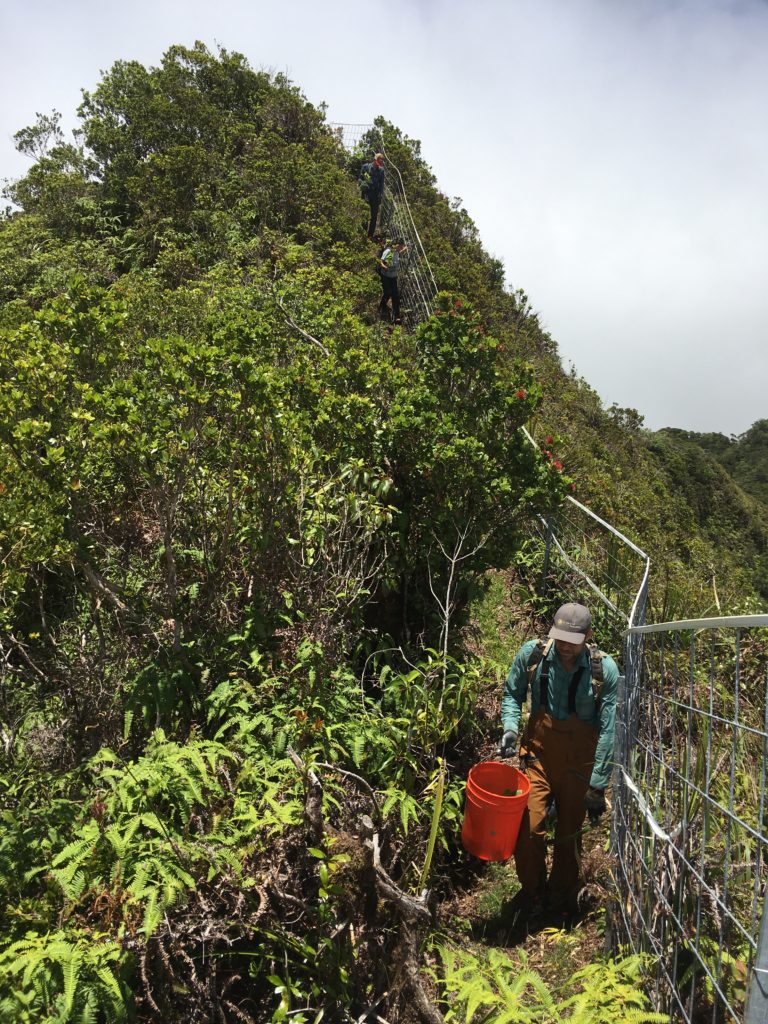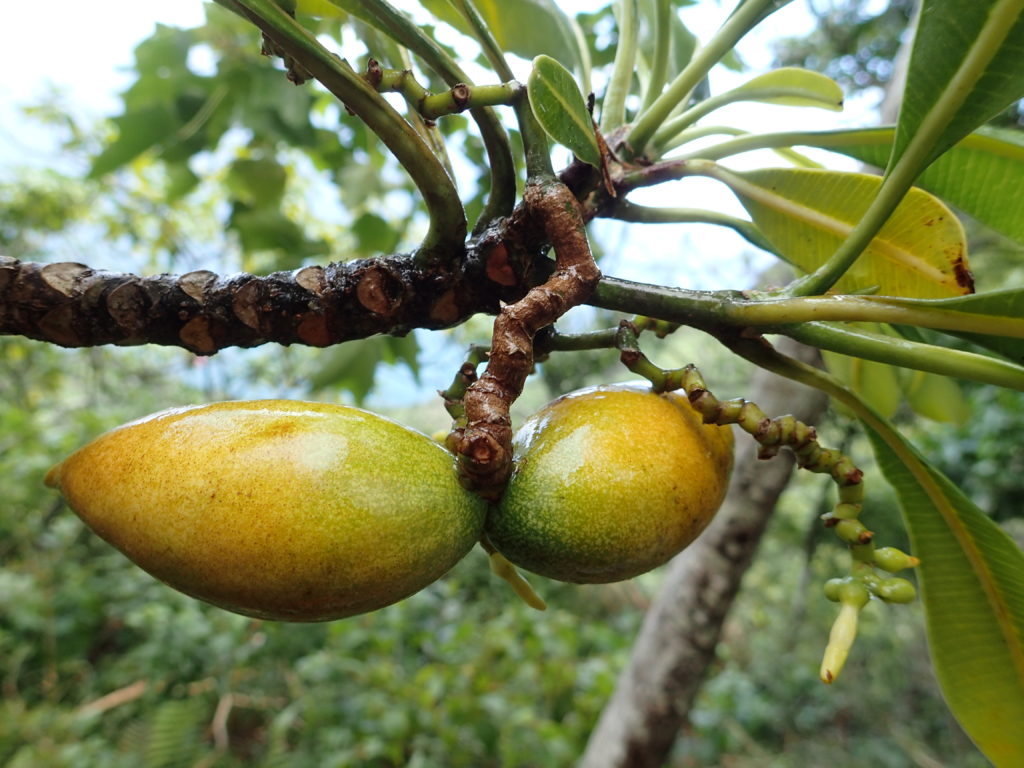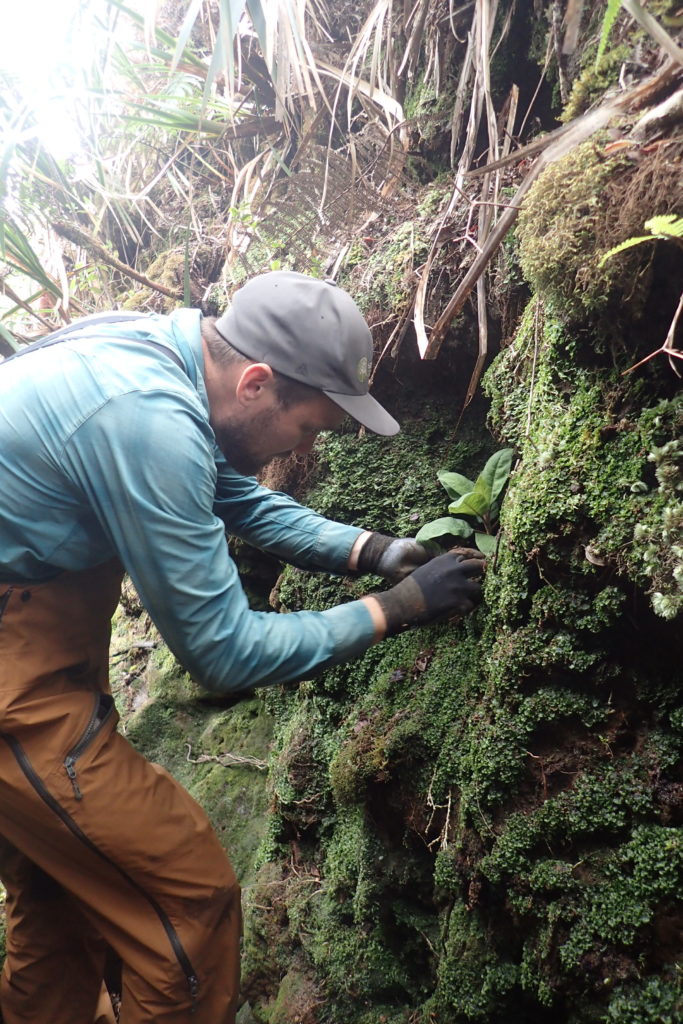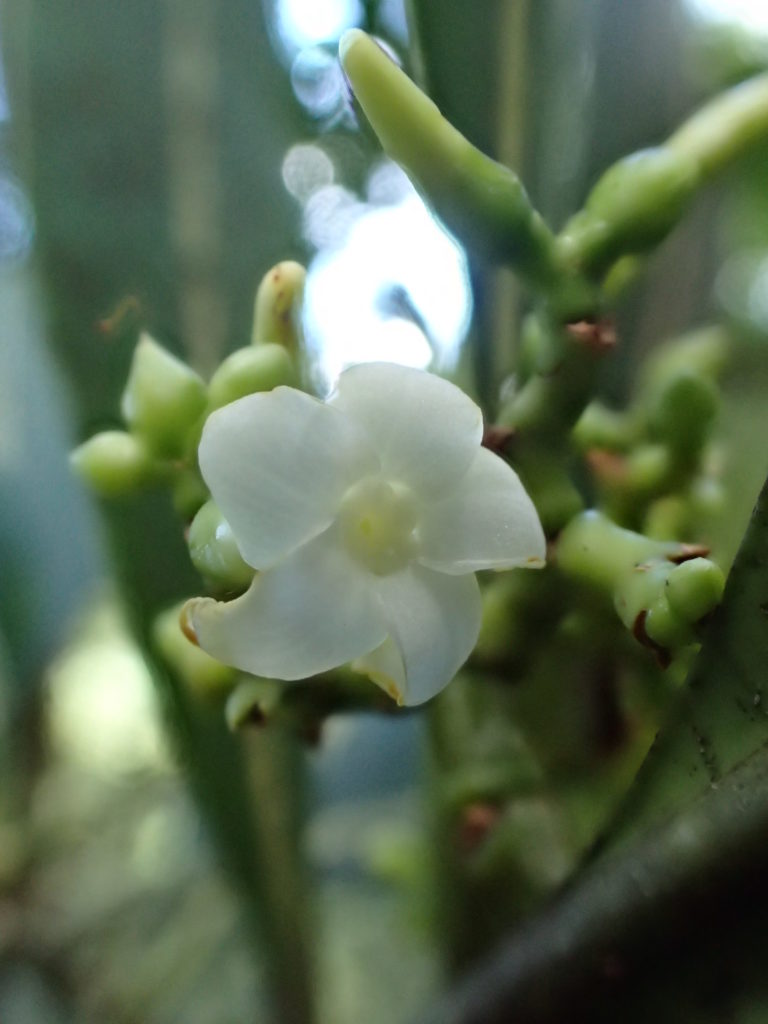And they’re coming back.
By Dr. Nina Rønsted, NTBG Director of Science and Conservation
Building on more than half a century of experience, NTBG has become an international leader in the conservation of endangered tropical plants. Partnering with local, state, federal, and private conservation agencies and organizations, our success stories are possible because our field botanists routinely botanize the mountains and valleys of Hawai‘i, other Pacific Islands, and tropical regions on foot, by helicopter, rappelling over cliffs, and using drones to locate, collect, and bring back important field observations and plant collections.

Maximizing the talents of our dedicated staff, volunteers, and like-minded partners, NTBG propagates and grows rare and endangered plants at our conservation nursery on Kaua‘i. Each year we outplant thousands of endangered and endemic species in our gardens and preserves where we can monitor and protect them. Seeds are collected, studied, and stored in our seed bank, and shared with other conservation bodies.
NTBG has collected or co-collected at least 19 endemic taxa which are believed to be extinct in the wild, but still grow in cultivation. Hawaiian species such as Delissea rhytidosperma, Kadua haupuensis, Kanaloa kahoolawensis, Stenogyne campanulata, and others might have gone completely extinct had it not been for our efforts.

In recognition of NTBG’s ongoing work, Fondation Franklinia, a Swiss private foundation that supports the conservation of globally threatened trees, funded a new project to conserve the endangered endemic trees of Kaua‘i. The project, called Securing the Survival of the Endangered Endemic Trees of Kaua‘i, Hawai‘i, runs from 2020 through 2022. Because Fondation Franklinia specifically targets the conservation of species in their natural habitat, this gave us a unique opportunity to focus on native trees in need of critical conservation. For this project, eleven species were selected which either previously grew in the Limahuli Valley or which still have a remnant population of less than ten individuals.
Knowledge of the historical occurrence of particular species in the Limahuli Valley comes from more than 40 years of monitoring and collecting by NTBG’s science and conservation team. Through these efforts, we have amassed a wealth of information stored in our herbarium and accompanying databases and in technical reports and scientific publications. Pollen profiles of sediment cores have also provided information about past species occurrences, and GIS mapping and potential habitat range analysis helps guide our understanding of conservation needs and opportunities.
The eleven taxa we are targeting for this project are: two species of Hawai‘i’s only native palm genus, Pritchardia limahuliensis and Pritchardia perlmanii; two sweet scented white Hibiscus, H. kokio subsp. saintjohnianus and H. waimeae subsp. hannerae; three lobeliads associated with pollination by nectar-feeding native honeycreepers, Cyanea hardyi, Cyanea kuhihewa, and Trematolobelia kauaiensis; as well as the lesser known Charpentiera densiflora, one of the few tree species in the Amaranth family (Amaranthaceae); also Ochrosia kauaiensis which is a yellowwood in the dogbane family; the curious Polyscias racemosa which produces a long racemose inflorescence with up to 250 tightly packed flowers; and the charismatic Gardenia remyi, a member of the coffee family (Rubiaceae).
Over the course of the three-year project, NTBG will be collecting and propagating seeds as well as using previous collections from our seed bank to balance the need for substantial seed collection of the few remaining plants. When the new treelets are strong enough, most will be outplanted in the Limahuli Preserve in relatively pristine areas or where weed control is ongoing.
To help protect them from seed predation, additional rat traps are being installed in the area. All of this work draws on many skilled science, conservation, and nursery staff from across NTBG, including the help of a full-time project dedicated KUPU member, Matthew Kahokuloa Jr., as part of the KUPU Conservation Leadership Development Program.

The re-introduction of these endangered, endemic trees to Limahuli Valley, where they once proliferated, will reinvigorate wild populations in the Limahuli Preserve where NTBG staff will be able to monitor them long into the future. Conservation collections will also be retained in NTBG’s seed bank, nursery and McBryde Garden. Mature trees representing several of the species are already thriving in the gardens, for example near the South Shore Visitors Center, where visitors may enjoy them up close.
Simultaneously targeting eleven endangered and endemic tree species is a confident step towards restoration of the diversity of native Hawaiian ecosystems. In the race to conserve Hawai‘i’s native forests, every step is critical. While trees are the major part of the biomass, healthy habitat also includes shrubs and herbs, as well native ferns and mosses, many of which also need a prioritized conservation effort.
Alongside the Fondation Franklinia project, and with the support of our members, collaborators and additional grants, NTBG remains dedicated to helping save as many endangered plant species — trees or otherwise — as possible as we work to protect and restore native ecosystems on Kaua‘i and beyond.


Trees are the foundation of forest ecosystems. To date, over 60,000 trees have been named and described globally. Since 2015, a Global Tree Assessment campaign, led by Botanical Gardens Conservation International (BGCI) and the International Union for Conservation of Nature’s IUCN Red List of Threatened Species, has been assessing the conservation status of the world’s trees. This enormous effort has resulted in the assessment of 45 percent of the world’s trees, roughly 38 percent of which are threatened with extinction. This means more than one in five of the world’s tree species faces extinction.
Because of isolation and wide range of climatic zones, Hawai‘i is a global hotspot of botanical diversity. Of the more than 1,360 known native Hawaiian plant species, nearly 90 percent, are unique to the islands. Many species are found only on one island or even a single ridge or valley. Approximately 13 percent of Hawai‘i’s native flora (more than 175 species) are trees. These include Hawaiʻi’s most common and foundational forest trees ʻōhiʻa (Metrosideros polymorpha) which is culturally very important, and koa (Acacia koa).
Hawai‘i also has a high extinction rate with an estimated 10 percent of the flora reported to have gone extinct since the 1840s. Over 50 percent of the species are considered threatened, primarily from the introduction of non-native plants which compete for habitat and destructive animals that eat seeds or foliage. These threats illustrate the importance of the Fondation Franklinia’s Securing the Survival of the Endangered Endemic Trees of Kaua‘i, Hawai‘i project.
